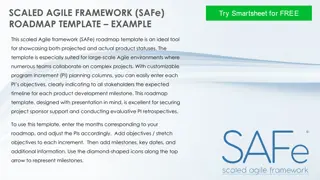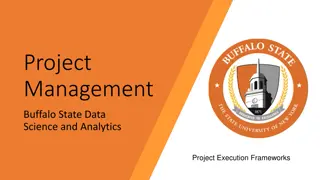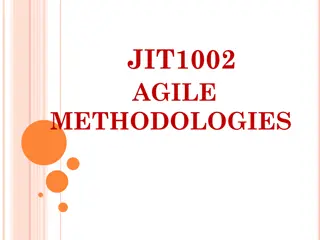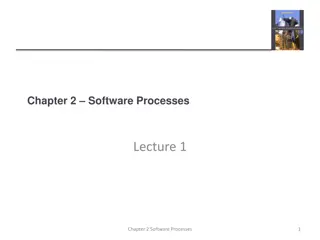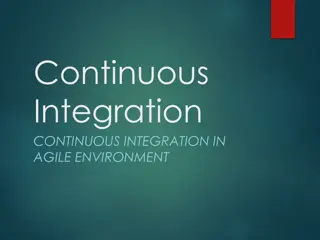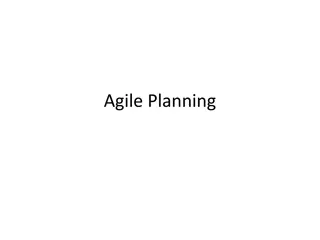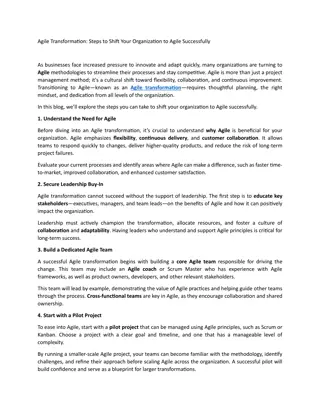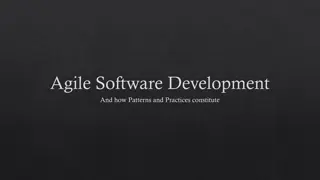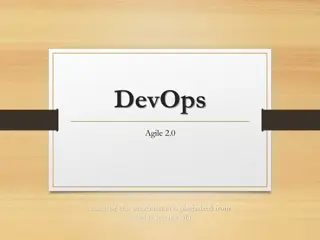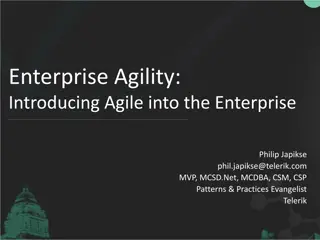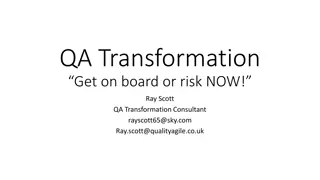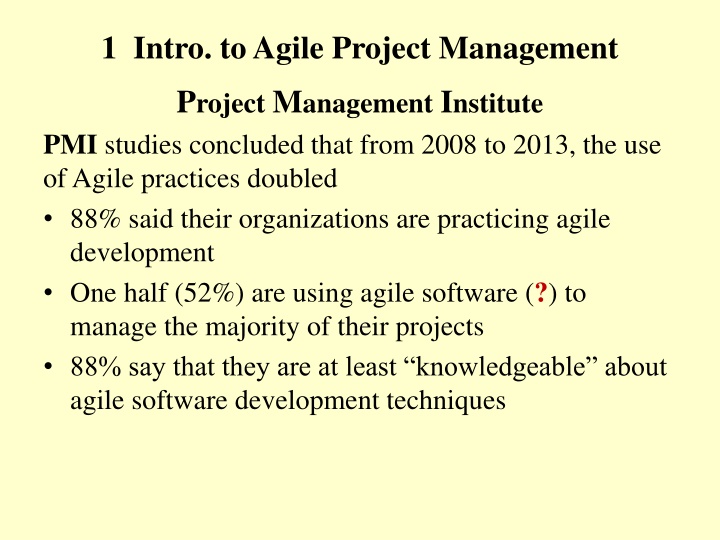
Evolution of Project Management Practices: Embracing Agility and Tradition
The evolution of project management practices showcases a rising adoption of Agile methodologies alongside traditional plan-driven approaches. Despite some tension between the two communities, there is a growing recognition of the need for a more integrated approach that leverages adaptive strategies in uncertain environments while maintaining core project management principles. The concept of Project Management Second Order (PM2) emphasizes combining linear processes with evolutionary and self-organizational principles for effective project goal attainment. This evolving landscape calls for project managers to adapt their roles to become more like coaches and consultants, fostering flexibility and quality integration throughout project lifecycles.
Download Presentation

Please find below an Image/Link to download the presentation.
The content on the website is provided AS IS for your information and personal use only. It may not be sold, licensed, or shared on other websites without obtaining consent from the author. If you encounter any issues during the download, it is possible that the publisher has removed the file from their server.
You are allowed to download the files provided on this website for personal or commercial use, subject to the condition that they are used lawfully. All files are the property of their respective owners.
The content on the website is provided AS IS for your information and personal use only. It may not be sold, licensed, or shared on other websites without obtaining consent from the author.
E N D
Presentation Transcript
1 Intro. to Agile Project Management Project Management Institute PMI studies concluded that from 2008 to 2013, the use of Agile practices doubled 88% said their organizations are practicing agile development One half (52%) are using agile software (?) to manage the majority of their projects 88% say that they are at least knowledgeable about agile software development techniques
The Chasm Limited amount of progress in developing a more integrated approach to project management that embraces both Agile and traditional plan driven project management principles and practices (??) Many see agile and project management principles and practices as competitive approaches Considerable polarization between these two communities is based in some part on myths, stereotypes, and misconceptions about what agile and project management is.
The role of a PM has been so strongly associated with someone who plans and manages projects using traditional plan driven project management approaches that many people cannot conceive of any other image of a project manager. To be successful in more uncertain environments, PMs need to be able to take an adaptive approach that is appropriate to the level of uncertainty in the project and integrate quality into the process rather than relying on final acceptance testing at the end of the project to validate that is produced. They need to give up some control that has become associated with the PM profession in some cases they need to become more of a coach & consultant
Mastering Complexity and Changes in Projects, Economy, and Society via Project Management Second Order (PM-2), Project Management Journal 41, no. 5 (Dec. 2010) traditional PM will play an active and important role but will be extended to consider dynamic, nonlinear, multi-causal structures and processes as well as the principles of self-organization, evolution, and networking.
Introduction Project Management Second Order (PM2) For an effective attainment of project goals at a defined finishing point in time, we need the linear processes and Cartesian causality and the Newtonian logic from Traditional project management. But evolutionary & self-organizing based management methods are necessary to master complex and uncertain situations on the way to the defined finishing point in time for a project. A well-balanced interaction of traditional PM and the evolutionary & self-organizational principles is the message of the Project Management Second Order (PM2)
Agile Project Management Benefits a strong believer inn agile, and there are some very significant benefits of an agile approach The real benefit to a typical project manager of developing an agile project management approach is not in throwing away any notion of using a plan-driven approach, converting to agile, and using a totally agile approach for all projects. Even if a project manager never uses a fully agile approach, knowledge of agile concepts and principles will make for a better project manager
Benefits of developing an Agile PM approach Assume that the approach is defined by the Agile Manifesto Values and the 12 Agile Principles The author s list of specific benefits : 1. Increased focus on business outcomes 2. Reduced time to market 3. Higher productivity and lower costs 4. Higher quality 5. Organizational effectiveness
1. Increased focus on business outcomes Not plan driven upfront specifications Team Collaboration with Product Owner / Business Analyst in specifying features and user needs (stories) Iterative development Prioritization of requirements Facilitated with oversight of Scrum Master
2. Reduced time to market Scrum methodology (Product Backlog and Sprint Backlog) Efficiency by delivering functionality incrementally Prioritization with team pulling highest priority not done work from the Product Backlog Focus on simplicity and elimination of non-value- added work
3. Higher productivity and lower costs Elimination of management overhead Sprint work focuses on highest priority not done feature/functions (pulling work and from the Product Backlog) Iterations in which the team completes that work required (the software designed, developed, fully tested and integrated) End of Sprint pulled work is done done
4. Higher Quality The goal at the end of each sprint is to produce go live ready code to complete an increment of shippable product Eliminating the cost of unfinished work and carrying forward technical debt
5. Organizational effectiveness The team is motivated and empowered to do their work and take price in do it well Given the team commitment, collaboration and support as well as all parts of the organization providing for the collaboration and focus on common goals
Review the Key Points page 13 There has been a widespread & rapid adoption of agile methodologies over the last 10 to 15 years however, our progress in developing and integrated approach to project management that embraces agile as well as traditional PM principles & practices has been somewhat limited. to get past a number of well-established stereotypes & develop a much broader vision of what project management is.
Comparison of agile versus waterfall there should be more accurately thought of as a range of adaptive and plan-driven approaches. agile versus waterfall comparison has created an impression that the approaches are competitive in fact, adaptive and plan-driven approaches really should be thought of as much more complementary to each other.
Transformation of the Project Management profession over the years, the profession has developed into a well-planned and disciplined approach to how projects are managed That approach has worked well for projects that can be heavily plan-driven. However, it has serious limitations in highly uncertain and rapidly changing environments that are difficult or impractical to plan
Agile project management benefits Developing a more adaptive approach to project management & tailoring the approach to fit the project will generally result in a number of benefits Matching the approach to the project rather than the default being the plan driven approach developing a broader and deeper knowledge of both adaptive and plan-driven principles and practices is likely to improve a project manager s skills for many different projects

